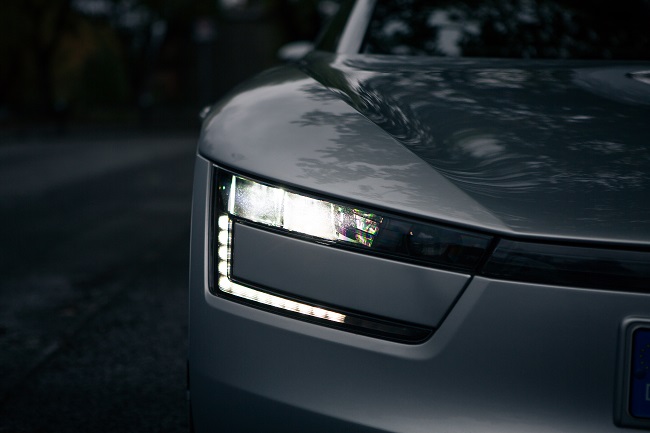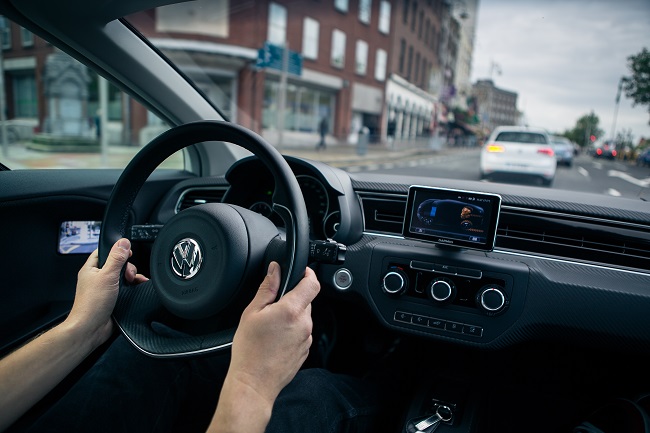The VW XL1 picked up considerable attention during its brief stopover in Dublin. Image via Paddy McGrath.
Last weekend, Dublin drivers may have caught a glimpse of an ultra-futuristic car travelling its roads in the form of the Volkswagen XL1, the world’s most fuel efficient car at 482km per gallon.
Yes you read that correctly, 482 km per gallon with its plug-in hybrid two-cylinder diesel engine. To put this into perspective, the current edition of the 2l VW Passat has an average somewhere in the region of 70km per gallon.
At first glance, there is nothing on the road remotely similar to the XL1 as its design is something that engineers in the 1960s would have considered the inevitable progression of car design, but was merely scrapped in the face of the realistic outputs of the car industry in the late 20th century.
Cars that looked more like planes did not ‘take off’ despite their expectations, but rather became slightly boxier and cost efficient for the manufacturer.
Thankfully, every now and then, a manufacturer throws out the rule book and makes a car that quite happily sticks out like a sore thumb.
Designed mostly as a play thing for VW’s engineers and tech divisions with only 250 being built, the XL1 has been developed across a 12-year period since its first incarnation, the L1, was launched back in 2002 followed seven years later by a 2009 model before finally coming to last year’s XL1.

The VW XL1 travelling through the Dublin Port Tunnel. Image via Paddy McGrath
Ruthless efficiency
The most distinctive aspect of the XL1 from the outset is its hidden rear wheels which, as I had mentioned earlier, was always seen as the future of car design that never really made it into real life.
Understandably, it poses the obvious question of what to do if it suffers a puncture, as ease of access is thoroughly eliminated and was thankfully something I avoided during my brief foray in the car.
The considerable benefit on the other hand is that it means less area where the air can flow which obviously adds to efficiency.
Even the wing mirrors have been removed to reduce even the smallest fraction of drag, or as my accompanying VW engineer, Patrick, whose blood and sweat is figuratively in the car, said is a bonus that prevents cyclists or pedestrians from getting hit.

Image via Paddy McGrath
Either way, as a driver who has had the ‘check your mirrors’ message drilled into him from day one, this was pretty unnerving.
Of course, you’re not left to the mercy of what’s surrounding your car as technology comes to the rescue in the form of two TV screens in each door panel, each showing a camera based in the back of the car giving a total field of vision which frankly, I wasn’t going to get used to during my test run.
The narrow side windows are, rather unsurprisingly, not made from heavier glass but rather polycarbonate, which Patrick was quick to point out was the same material used in fighter jets and weighs 2.6kg less than its traditional counterpart.
For those interested in the science of how streamlined this car is, it has drag co-efficient of 0.189, which puts it somewhere in between the aerodynamic abilities of a Formula One car and a penguin.
Not-so futuristic driving
With all the efficiency technology crammed into the car, you’d expect you might be in for a smooth ride. Well, think again.
Quite frankly, I’ve come to learn that when it comes to ruthless efficiency in a car, engineers see the passenger as an unnecessary weighty extra.
For one thing, that little piece of technology that has existed in all cars since the 1990s, power steering, is deemed a luxury in weight as the standard system in a car weighs about 15kg while the XL1’s weighs a third of this.
Again, comfy seats with heating or adjustable positions are for the regular folk as in the XL1, you have lighter bucket seats which weigh about half the amount of a standard seat.

Image via Paddy McGrath
So what does all this mean for the actual driving experience? For a car that costs €110,000 it’s a simple car to drive with its automatic gearbox, but that’s where my praise for it ends.
Taking the last electric-powered car I drove for Siliconrepublic.com, the BMW i3, which showed incredible acceleration, the car starts sluggishly with the electric motor, only for the diesel motor to kick in after a few seconds to increase its speed – nothing that sets the world on fire.
After all, it is a ruthlessly efficient car and speed does not fit in this category, but I found myself having to put my foot all the way down like a go-kart to get to an acceleration I was used to.
The gearbox also proved tricky, as the difference between neutral and reverse was minute, with Patrick at one point having to change gear for me as it was that hard to tell the gears apart.
A car for collectors
It’s rather hard to put the XL1 in the same critical light as, say, a consumer car.
For one thing, it’s hard to even categorise it as a consumer car, as its €110,000 price tag puts it out of reach of almost every car buyer, as well as the fact only 250 have been built in the entire world.
As I’ve mentioned, the car doesn’t even handle well and someone would no doubt find the omission of power steering the bane of their existence after awhile, even if it would mean they would be able to ease some of their financial burden via the car’s incredible fuel efficiency.
It is, without doubt, a car for their serious collectors with its wacky design and scarcity, but this reviewer hopes that what is essentially a test vehicle will pave the way for future advancements for those in the real world, not in science fiction.

Image via Paddy McGrath